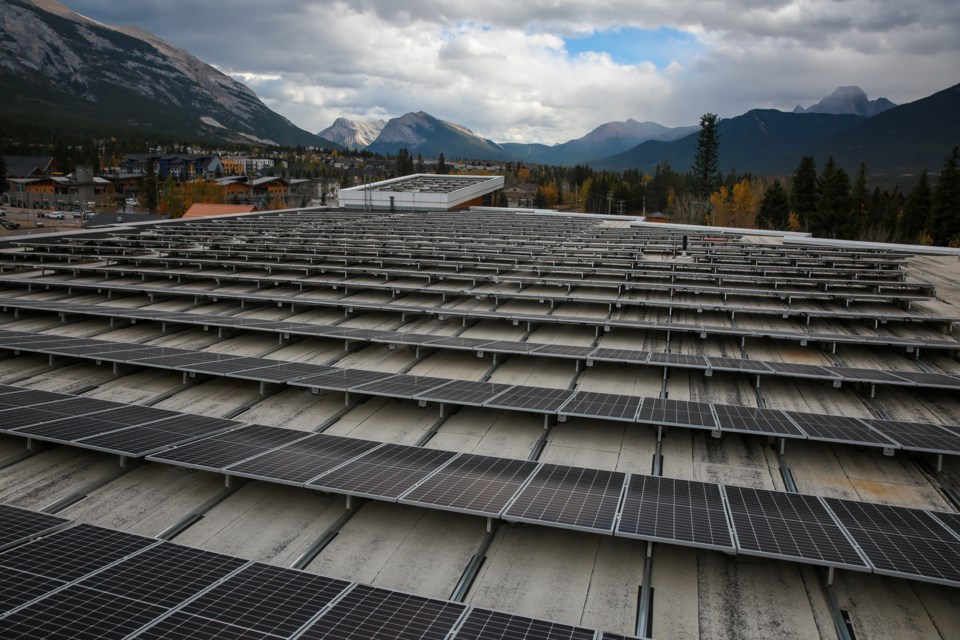CANMORE – Council received an update on what has been achieved and what will occur as part of the Town’s Climate Action Plan.
However, the biggest helper and one out of council’s control – the release of an updated national building code – will ultimately be the biggest benefactor in helping Canmore achieve its climate goals.
The national building code, which will emphasize net-zero building, is expected to be released in the coming year.
“It is one of the most, if not the single most important policies, to enable us to meet our community-wide targets,” said Amy Fournier, the Town of Canmore's energy and climate action coordinator at the Jan. 18 committee of the whole meeting. “As Canmore continues to grow, every building that’s built to current Alberta building codes ends up adding GHGs (greenhouse gases) to our community and making our targets harder to achieve.
“The intent of the net-zero energy ready code is that houses will be net-zero ready and built in such a way that the energy used over the course of the year could be met with renewable energy installation on site.”
Until the federal building code is released and the province adopts it, Fournier said the path to the Town’s climate goals is tough.
She highlighted other aspects out of the Town’s control, such as the province’s move away from coal-fired electricity to primarily natural gas, which will help Canmore due to it being less carbon intense. The switch will significantly reduce GHGs.
However, without a net-zero building code, there are still facets that are largely out of the hands of community members.
During cold weather, such as the lengthy cold snap the Bow Valley experienced in December, people are more likely to use heating and natural gas use increases.
“As we move forward and hopefully get to the net-zero ready building code, having buildings built with really high performing building envelopes just means there’s less heating demand and that we can hopefully see that natural gas going down,” Fournier said. “But until we have that ... we will continue to see natural gas go up, especially when we have cold winters.”
A staff report stated the Town spent about $1.74 million on electricity and natural gas costs and a further $165,000 on diesel and gasoline in 2020. Across the community, it was estimated about $34 million was spent by residents and businesses on electricity and natural gas.
The Town introduced its Climate Action Plan in Dec. 2018 to reduce community-wide GHGs by 30 per cent by 2030 and 80 per cent by 2050. For municipal property, it was set at a 50 per cent reduction by 2030 and 80 per cent by 2050.
The plan has 65 separate actions that are split into four categories of energy-efficient buildings, renewable energy, low carbon transit and waste reduction.
Fournier said 51 per cent of the actions have either been implemented, are in progress or planned to move forward. Some of the actions are fare free transit, solar panels, the clean energy improvement program (CEIP), grant initiatives and electric vehicle charging.
Through studies in the community GHG inventory, Fournier said there had been a slight drop in GHGs in the community between 2015 and 2018. The next study is set to take place this year based on the 2021 information.
The goals for this year are a renewable energy feasibility study, commercial and residential food waste diversion, the 2023-30 climate action plan implementation schedule, the residential clean energy improvement program and the community electric vehicle charging.
The previous council also made a climate emergency declaration in Oct. 2019 to further acknowledge the severity of global climate change.
According to statistics provided by Fournier, the Town’s GHGs count for roughly four per cent of those in the community. In Canmore, 34 per cent of GHGs come from transit, 33 per cent from commercial and institutional buildings, a further 26 per cent from residential buildings and seven per cent from waste.
Mayor Sean Krausert acknowledged the difficult road ahead in reaching the 30 per cent goal, particularly with Canmore growing. He did note promoting programs coming from the Climate Action Plan will hope to increase further buy-in from residents.
“If we promote CEIP and get a lot of buy-in and be prepared so people can actually follow through on their surveyed intention to buy an electric vehicle in the next five years and have some facilities here, we can move the needle.”
Fournier highlighted how she and the Town’s communications department are working to create a section of the Town’s website people can view to see how the community is doing in reducing GHGs. She said the aim is to have it before the end of the year in easy to read information for the average person to understand.
“It will probably increase buy-in, combined with what we put out and the Biosphere puts out and all of those things together we can start to move that needle and really make it a community effort,” Krausert said.




